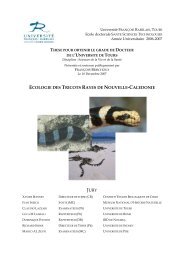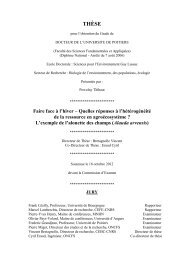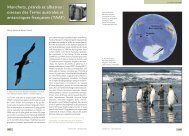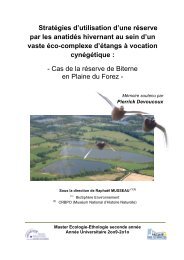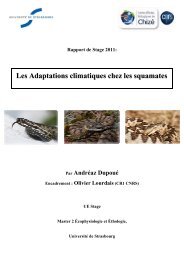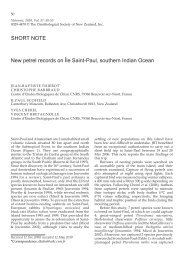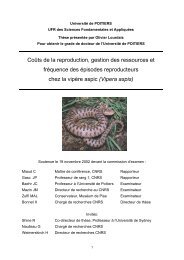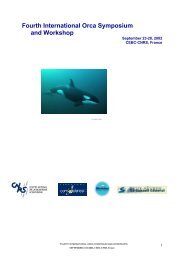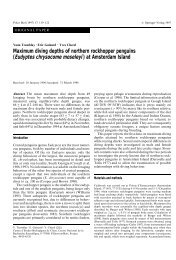Forçage environnemental et prédateurs marins ... - Cebc - CNRS
Forçage environnemental et prédateurs marins ... - Cebc - CNRS
Forçage environnemental et prédateurs marins ... - Cebc - CNRS
You also want an ePaper? Increase the reach of your titles
YUMPU automatically turns print PDFs into web optimized ePapers that Google loves.
Table 1. Results of the final reduced mixed model showing variables<br />
with significant effects on annual breeding success of white-chinned<br />
p<strong>et</strong>rels at Possession Island b<strong>et</strong>ween 1986 and 2004. Test statistics (F<br />
and P values) are type III, and df (numerator, denominator) for fixed<br />
effects were estimated using the Satterthwaite approximation.<br />
Goodness-of-fit: χ 2 /df = 0·91.Variance components plus their SE are<br />
shown for random effects<br />
Effect F df P Estimate SE<br />
Fixed effects<br />
Intercept 15·76 1, 27·35 < 0·001 −2·657 0·669<br />
Trend 8·92 1, 18·28 0·008 0·387 0·130<br />
Trend 2<br />
5·99 1, 14·01 0·028 −0·014 0·006<br />
TOOTH<br />
Random effects<br />
4·69 1, 14·68 0·047 0·387 0·179<br />
Burrow 0·155 0·134<br />
Year 0·248 0·189<br />
Residual variance 0·909 0·066<br />
Fig. 1. White-chinned p<strong>et</strong>rel breeding success at Possession Island as<br />
a function of year. Regression line is estimated from the statistical<br />
model in Table 1. Error bars indicate SE.<br />
was 7531, and the number of breeding pairs was estimated at<br />
5321. Burrow d<strong>et</strong>ection probability (Supplementary Material<br />
Appendix S1) was estimated in 2004 at 0·92 ± 0·02 (CI95:<br />
0·88–<br />
0·95). Assuming a constant d<strong>et</strong>ection probability, the number<br />
of breeding pairs was estimated at 8377 (CI95:<br />
8020–8733) and<br />
5783 (CI95:<br />
5538–6028) in 1983 and 2004, respectively. The<br />
number of breeding pairs declined by 37·1% in 21 years, corresponding<br />
to a λ of 0·983 ± 0·001 (i.e. an average rate of<br />
decline of 1·76% per year), lower than 1 ( z = 12·16, P < 0·001).<br />
BREEDING SUCCESS<br />
The mean breeding success during the period 1986–2004 was<br />
38·2% (± 4·2). Breeding success increased nonlinearly during<br />
the study period (Table 1), varying around an average of<br />
51·4% since 1995 (Fig. 1). None of the climate covariates were<br />
found to affect breeding success (Table 1). Fishing effort for<br />
toothfish had a positive effect on breeding success (Table 1).<br />
The generalized linear mixed effect model including the<br />
effects of these significant variables explained 68·5% of the<br />
variance in breeding success. The random effect for burrow<br />
Effect of climate and fisheries on p<strong>et</strong>rel dynamics<br />
© 2008 The Authors. Journal compilation © 2008 British Ecological Soci<strong>et</strong>y, Journal of Applied Ecology,<br />
45,<br />
1460–1467<br />
1463<br />
Table 2. Modelling the impact of climatic and fishery covariates on<br />
survival. T and T respectively indicate linear and quadratic trends; df<br />
(numerator, denominator)<br />
Model F df P Slope CI 95<br />
ST 2·432 1, 16 0·138<br />
S 2<br />
T + T<br />
SSOI 4·262<br />
0·073<br />
2, 15<br />
1, 16<br />
0·034<br />
0·792<br />
SSOI−3 60·39 1, 16 < 0·001 2·640 0·631–4·650<br />
SSOI−4 0·870 1, 16 0·365<br />
SSSTALT 0·628 1, 16 0·439<br />
SSSTAST 0·001 1, 16 1<br />
SSSTAw 0·143 1, 16 0·710<br />
STOOTH 0·005 1, 16 0·500<br />
SHAKF 0·983 1, 16 0·168<br />
SNKILL 0·369 1, 16 0·276<br />
identity accounted for 11·8% of the total variance in breeding<br />
success (calculated as the sum of the burrow identity, year and<br />
residual variance components).<br />
AGE AT FIRST BREEDING AND JUVENILE SURVIVAL<br />
The mean observed age at first breeding was 6·1 years (± 0·3,<br />
n = 16, min = 4, max = 9). Most (87·5%) individuals were<br />
observed breeding for the first time b<strong>et</strong>ween 4 and 7 years of<br />
age. Only 16 (4%) of the 401 chicks ringed since 1986 were<br />
observed as breeding recruits in the colony. Excluding the last<br />
7 years of the study for which the recruitment process was not<br />
terminated, the average r<strong>et</strong>urn rate was 9%, and the average<br />
annual juvenile survival was low and estimated at 39·3% with<br />
a low precision (SE = 29·2%).<br />
ADULT SURVIVAL<br />
The GOF test indicated that the Jolly–Move model fitted the<br />
2<br />
data satisfactorily ( χ63 = 136⋅33, P = 0·97). Modelling the<br />
recapture probability indicated that it was constant across<br />
years (Supplementary Material Table S1), and high (0·826 ±<br />
0·057, CI95: 0·686–0·911). Transition probabilities varied<br />
according to state but not year. Local survival of adults was<br />
estimated at 0·895 ± 0·019 (CI95: 0·851–0·928). Transitions<br />
b<strong>et</strong>ween states were not random. Non-breeders in year t were<br />
less likely to become breeders in year t + 1 (0·178 ± 0·058)<br />
than breeders in year t (0·766 ± 0·042).<br />
Only SOI−3 was related to the probability of adult survival<br />
(Table 2), and explained 73·3% of its variability. Adult survival<br />
was positively related to SOI−3 (Fig. 2), indicating that<br />
adult survival decreased 3 years after El Niño events. The<br />
effect of SOI−3 was strong, the F-test remaining significant<br />
after correction of the P value using the Bonferroni m<strong>et</strong>hod.<br />
RECRUITMENT<br />
The GOF test of the more general model ptγt, where p and γ<br />
are respectively the capture and seniority (1-recruitment)<br />
2<br />
probabilities, was significant ( χ63 = 136⋅33, P < 0·001). The lack<br />
2<br />
of fit was due to Test 2.Ct ( = 8315 ⋅<br />
, P < 0·001), indicating<br />
χ 16



